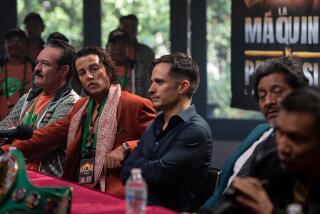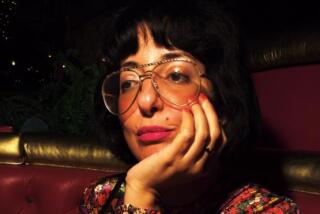Review: Adapted as a series for HBO, Elena Ferranteâs âMy Brilliant Friendâ is like Italian opera, soapy but sincere
The first of Elena Ferranteâs four âNeapolitanâ novels, âMy Brilliant Friendâ has become a television series in eight parts, a co-production between Italian studios and HBO, where it begins airing Sunday.
Ferrante â the name is a pseudonym, the author remains remarkably unknown and unheard from, barring an occasional epistolary interview â is a writer of general appeal and critical plaudits who combines the fizz of popular fiction with a nuanced interest in social mores and and interior states. (My copy of âMy Brilliant Friendâ comes with blurbs from Alice Sebold, John Powers, John Waters and Gwyneth Paltrow.)
Directed by Saverio Costanzo (âHungry Heartsâ), this screen translation â much of it spoken in a Neapolitan dialect that requires subtitling even in Italy â is similarly energetic and thoughtful and redolent of Ferranteâs evocative but never flowery prose. It takes awhile to catch fire, and for a viewer even to get his bearings, so numerous are its characters; but it does, and you will.
Superficially, it can be seen as a high-toned Italian turn on âBeaches,â the Barbara Hershey-Bette Midler film, and âOld Acquaintance,â before it, with Miriam Hopkins and Bette Davis: decade-spanning tales of female friendship, difficult masculinity and personal fulfillment (and disappointment). It is not what youâd call a soap opera, but it simmers with all the ingredients of one â family honor and dishonor, love, sex, class war and a criminal element.
The books tell the story of of Lila Cerullo (Ludovica Nasti as a child, Gaia Girace as an adolescent) and LenĂš Greco (Elisa Del Genio, younger, Margherita Mazzucco, older), from 6 to 66. (The first volume gets them to 16.) LenĂš, whose father was a porter at city hall, narrates retrospectively, tracing the course of their variable yet indivisible friendship.
Lila, a shoemakerâs daughter, is one of those remarkable personalities one does encounter real life, as impossible as they seem: preternaturally self-contained, a person seemingly outside of time and society, whose thoughts seem all original, prodigiously self-taught, perceptive and impulsive, certain in her actions but quite capable of putting a foot wrong.
LenĂš is smart too, if less original, bound by convention and a desire to please. She depends on Lila for inspiration, and their competitive/supportive relationship is the spine on which the novels hang. Other characters come and go, intersecting the orbit, perhaps seeming to threaten it, before heading back into space.
A big-canvas, close-quartered drama populated by whole families variously in cahoots and at odds, among themselves and with each other, it is set in the 1950s, largely in a working-class satellite neighborhood of Naples -- a sort of island of four-story apartment blocks hemmed in by a berm along which trains run and through which a tunnel leads to a highway that leads, it is rumored, to the sea.
As in every adaption, there will be something to disappoint the fans. (Ferrante was involved in the writing in an advisory fashion.) There are some practical compressions and minor chronological rejiggering â the book and the series reach an identical midpoint â but nothing of import was left out, and the novelâs big scenes â a rock ânâ roll dance party, a fireworks battle, a trip to Naples that, like much else here, suddenly turns violent â and its most striking images are for the most part powerfully rendered. (Lila suddenly flying out a window is breathtaking, even when you know itâs coming.)
Built for the series in Caserta, near Naples, the neighborhood is itself a sort of a character â containing what for much of the series is the girlsâ whole world. In the earliest episodes, the cityscape feels barren, artificial and dreamlike, like something out of Antonioni or Fellini; shops, such as there are, are seen only from the outside. Later, the palette, at first all dusty browns and grays, grows more varied â though remaining, for the most part, pale, like a hand-colored photograph â the streets fill with ordinary life, stores are entered into.
None of the four girls who play Lila and LenĂš acted before âMy Brillilant Career,â and while they arenât always quite up to incarnating an emotion, their presence always registers; the camera drinks in their faces with a regard that might be called religious. Lila is an especially difficult character to inhabit. Nasti, who plays her when little, catches her fury, certainly, though one needs to take her intellectual brilliance somewhat on faith.
But Girace, who is just 14, is increasingly fine as the script asks more of her; dark and thin, seeming to keep something secret behind her eyes, she can stand up to older actors and intimidate the intimidating characters they play. And Mazzucco, 15, blossoms as the story sends her out into the world. That both teenagers are tall and can look older than they are makes the often aggressive courtship of adolescent girls by older boys (and men) at least visually less disconcerting than it might be â though disturbing enough when you think for a moment.
The theme of predatory and proprietary men arranging the lives of girls and women makes the series timely (though one might also call it timeless). There is revolution in the air here, though, if tentatively approached. As to what the future may bring, there are three novels still to adapt â and little doubt, given âMy Brilliant Friend,â that they will be.
âMy Brilliant Friendâ
Where: HBO
When: 9 p.m. Sunday
Rating: TV-MA (may be unsuitable for children younger than 17)
ALSO:
In a rare interview, Elena Ferrante describes the writing process behind the Neapolitan novels
Maggie Gyllenhaal wrote Elena Ferrante a letter. Now sheâs directing âThe Lost Daughterâ
Follow Robert Lloyd on Twitter @LATimesTVLloyd
Follow Robert Lloyd on Twitter @LATimesTVLloyd
More to Read
The complete guide to home viewing
Get Screen Gab for everything about the TV shows and streaming movies everyoneâs talking about.
You may occasionally receive promotional content from the Los Angeles Times.







